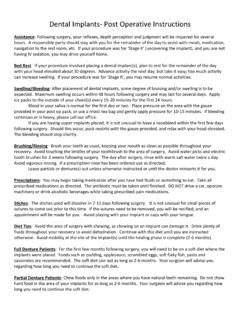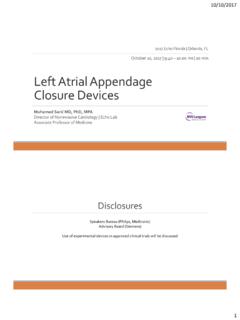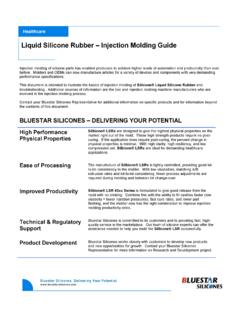Transcription of Guidance for management of troublesome vaginal …
1 Initial consultation Provide accurate Information about expected bleeding patterns, emphasising that troublesome bleeding is likely to improve with time:Implant: 1/5 amenorrhoea, 3/5 infrequent, irregular bleeding, 1/5 frequent or prolonged bleeding; approximately 1/2 with frequent or prolonged bleeding will improve after three IUD: frequent spotting/bleeding common in first 3-5 months; either amenorrhoea, light irregular or light regular bleeding common after six Injection: 1/2 amenorrhoea, 1/6 infrequent irregular bleeding, 1/3 frequent/prolonged bleeding; amenorrhoea increases over time.
2 Be proactive in offering management advice for troublesome bleedingActively encourage review of troublesome bleeding. Contraindications include:1 migraine with aura, personal and family history of venous thromboembolism, risk factor for cardiovascu-lar disease and smoking >35 years of age, active breast cancer. For other conditions see: upper gastrointestinal inflammation or ulceration, renal conditions 3 contraindications include active thromboembolic disease and subarachnoid haemorrhage 4 contraindications include active thromboembolic disease and subarachnoid haemorrhage 5 at high risk of venous thromboembolism, ischemic heart disease or stroke6 active breast cancerManagement of troublesome bleeding1.
3 Exclude other causes Pregnancy, sexually transmitted infections (STIs) including chlamydia, liver-enzyme inducing medications (implant only) and vaginal , cervical or uterine pathology2. If no suspicion of another cause for bleedingReassure this is normal and not harmful3. Advise medication managementEnsure no contraindications and explain risks and side effects4. Advise that the implant or hormonal IUD can be removed any time or the depot medroxyprogesterone acetate (DMPA) injection line options: A combined hormonal contraceptive1 taken continuously or cyclically for three months Five day course of NSAID2 such as mefenamic acid 500mg bd-tds Five day course of tranexamic3 acid 500mg bd, particularly if bleeding is heavySecond line options With low level, anecdotal or conflicting evidence.
4 Tranexamic4 acid 500mg bd for five days for lighter bleeding Norethisterone5 5mg tds for 21 days Levonogestrel6, progestogen only pill, 30 mcg bd for 20 days Early removal and replacement of implant or hormonal IUD, or shortening interval between injections from 12 to 10 weeksGuidance for management of troublesome vaginal bleeding with progestogen-only long-acting reversible contraception (LARC)Medication management strategies for progestogen-only contraception related bleeding: While medications used to manage troublesome bleeding do not have an effect on future bleeding patterns once stopped, they may support continued use of a LARC that would otherwise have been discontinued due to troublesome Hormonal Contraceptive Women who do not have any contraindications to oestrogen can be prescribed a pill or vaginal ring for three months.
5 When stopped, the woman will experience a hormone withdrawal bleed and generally resume her earlier pattern of bleeding. A PBS-listed levonorgestrel or norethisterone pill is generally advised, although any pill or the vaginal ring can be used. The pill or ring can be used continuously or cyclically. Continuous users can take a four day break if troublesome bleeding recurs. The pill or ring can also be used for short periods of time intermittently. Implant Expert opinion supports the safety of use of the pill or ring to control bleeding beyond three months.
6 These methods can be used concurrently for the duration of implant pill or ring may be used to manage DMPA-related bleeding for a maximum of three months. Hormonal IUDUse of the pill or ring with the hormonal IUD may have some applicability but use beyond three months is rarely needed and is not Anti Inflammatory Drug (NSAID)A five day course of an NSAID may be used to shorten the duration of a bleeding episode and decrease blood loss in women who cannot tolerate or have a contraindication to pill or ring. It is unlikely to be useful long term, but if successful a five day course can be repeated medication-related strategies: Tranexamic acidThere is limited information that tranexamic acid reduces the duration of bleeding episodes.
7 If successful a five day course can be repeated opinion in the UK suggests that high dose progestogens such as Norethisterone 5mg tds may be useful for short term control of troublesome bleeding (it should not be used by women with risk factors for VTE). Long term use is not only pillThere is limited information that the levonorgestrel progestogen-only pill (POP)reduces the duration of troublesome bleeding episodes. It can be given as a twice daily dose or two taken together. If successful a 20 day course can be repeated at any time.
8 Early removal and replacement of a contraceptive implant or hormonal IUD or reducing the interval of DMPA injections from 12 weeks to 10 weeks may be associated with an improved bleeding pattern in some women. References1. Mansour D, et al. Eur J Contracept Reprod Health Care. 2008;13 Suppl 1 Suvisaari J, et al. Contraception. 1996;54(4) Sangi-Haghpeykar H, et al. Obstet Gynecol. 1996;88(2) Said S, et al. Contraception. 1987;35(6) Abdel-Aleem H, et al. Cochrane Database Syst Rev. 2013;10 Mestad R, et al.
9 Contraception. 2011;84(5) O Neil-Callahan M, et al. Obstet Gynecol. 2013;122(5) Winner B, et al. The New England journal of medicine. 2012;366(21) Venous Thromboembolism (VTE) and Hormonal Contraception: Faculty of Sexual and Reproductive Healthcare (UK); 2014. 16 p. management of Unscheduled Bleeding in Women Using Hormonal Contraception. Faculty of Sexual & Reproductive Healthcare Clinical Guidance . Clinical Effectiveness Unit; Dickson J, et al. Journal of Family Planning and Reproductive Health Care.
10 2014;40(3) Mansour D, et al. Contraception. 2011;83(3) accurate information and a proactive approach to management options for troublesome bleeding in users of the implant (Implanon NXT ), hormonal-IUD (Mirena ) and the DMPA injection is a useful strategy to improve use of LARC. All women should be given evidence-based information about expected bleeding patterns during the contraceptive consultation including: The pattern an individual woman will experience cannot be predicted Bleeding is not associated with a reduction in contraceptive effectiveness The bleeding is not a period but comes from the effect of the hormones on the endometrium Information about strategies for management of troublesome bleeding and encouragement to seek adviceFurther information






